New Activated Carbon from Mine Coal for Adsorption of Dye in Simulated Water or Multiple Heavy Metals in Real Wastewater
Abstract
:1. Introduction
2. Materials and Methods
2.1. Materials
2.2. Preparation of Nano-Activated Carbon (NAC)
2.3. Batch Mode Adsorption Experiment
2.4. Determination of Heavy Metals Adsorption Capacity from Real Wastewater
2.5. Adsorption Isotherms
2.6. Determination the Physico-Chemical Properties of Prepared Materials
3. Results and Discussion
3.1. Structural Identification and Characterization of Activated Carbon Derived from El-Maghara Mine Coal
3.2. Effect of Oxidation Treatment Conditions on MB Adsorption
3.3. Adsorption Equilibrium
3.4. Adsorption Model of NAC Material
3.5. Assessment of Optimum Prepared NAC and Its Parent Raw Coal for Multi Heavy Metals Adsorption from Real Petrochemicals Discharged Wastewater
4. Conclusions
Author Contributions
Funding
Conflicts of Interest
References
- Elkady, M.F.; Shokry, H. Invention of hollow zirconium tungesto vanadate at nanotube morphological structure for radionuclides and heavy metal pollutants decontamination from aqueous solutions. Nanoscale Res. Lett. 2015, 10, 474. [Google Scholar] [CrossRef] [PubMed] [Green Version]
- Elkady, M.F.; Shokry, H. Equilibrium and dynamic profiles of azo dye sorption onto innovative nano-zinc oxide biocomposite. Curr. Nanosci. 2015, 11, 805–814. [Google Scholar] [CrossRef]
- Mehmet, E.A.; Sukru, D.; Celalettin, O.; Mustafa, K. Heavy metal adsorption by modified oak sawdust: Thermodynamics and kinetics. J. Hazard. Mater. 2007, 141, 77–85. [Google Scholar]
- El-Nabarawy, Y.A.M.; El-Shafey, E.I. Modified activated carbons from olive stones for the removal of Heavy Metals. Carbon Sci. 2006, 7, 1–8. [Google Scholar]
- Kouras, A.; Zouboulis, A.; Samara, C.; Kouimtzis, T. Removal of Pesticides from Aqueous Solutions by Combined Physicochemical Processes – the Behaviour of Lindane. Environ. Pollut. 1998, 103, 193–202. [Google Scholar] [CrossRef]
- Hamad, H.; Bailón-García, E.; Maldonado-Hódar, F.J.; Pérez-Cadenas, A.F.; Carrasco-Marín, F.; Morales-Torres, S. Synthesis of TixOy nanocrystals in mild synthesis conditions for the degradation of pollutants under solar light. Appl. Catal. B Environ. 2019, 241, 385–392. [Google Scholar] [CrossRef]
- Sadik, W.A.; El-Demerdash, A.M.; Nashed, A.W.; Mostafa, A.A.; Hamad, H.A. Highly efficient photocatalytic performance of Cu2O@TiO2 nanocomposite: Influence of various inorganic oxidants and inorganic anions. J. Mater. Res. Technol. 2019, 8, 5405–5414. [Google Scholar] [CrossRef]
- Hamad, H.; Castelo-Quibén, J.; Morales-Torres, S.; Carrasco-Marín, F.; Pérez-Cadenas, A.F.; Maldonado-Hódar, F.J. On the interactions and synergism between phases of carbon–phosphorus–titanium composites synthetized from cellulose for the removal of the Orange-G dye. Materials 2018, 11, 1766. [Google Scholar] [CrossRef] [Green Version]
- El-Ashtoukhy, E.-S.Z.; Amin, N.K.; El-Latif, M.M.A.; Bassyouni, D.G.; Hamad, H.A. New insights into the anodic oxidation and electrocoagulation using a self -gas stirred reactor: A comparative study for synthetic C.I Reactive Violet 2 wastewater. J. Clean. Prod. 2017, 167, 432–446. [Google Scholar] [CrossRef]
- Hamad, H.; Bassyouni, D.; El-Ashtoukhy, E.; Amin, N.; El-Latif, M.A. Electrocatalytic degradation and minimization of specific energy consumption of synthetic azo dye from wastewater by anodic oxidation process with an emphasis on enhancing economic efficiency and reaction mechanism. Ecotoxicol. Environ. Saf. 2018, 148, 501–512. [Google Scholar] [CrossRef]
- Shalaby, T.; Hamad, H.; Ibrahim, E.; Mahmoud, O.; Al-Oufy, A. Electrospun nanofibers hybrid composites membranes for highly efficient antibacterial activity. Ecotoxicol. Environ. Saf. 2018, 162, 354–364. [Google Scholar] [CrossRef] [PubMed]
- Huang, Y.; Wu, D.; Wang, X.; Huang, W.; Lawless, D.; Feng, X. Removal of heavy metals from water using polyvinylamine by polymer-enhanced ultrafiltration and flocculation. Sep. Purif. Technol. 2016, 158, 124–136. [Google Scholar] [CrossRef]
- Huang, Y.; Feng, X. Polymer-enhanced ultrafiltration: Fundamentals, applications and recent developments. J. Membr. Sci. 2019, 586, 53–83. [Google Scholar] [CrossRef]
- Bassyouni, D.; Mohamed, M.; El-Ashtoukhy, E.; Abd El-Latif, M.; Zaatout, A.; Hamad, H. Fabrication and characterization of electrospun Fe3O4/o-MWCNTs/ polyamide 6 hybrid nanofibrous membrane composite as an efficient and recoverable adsorbent for removal of Pb (II). Microchem. J. 2019, 149, 103998. [Google Scholar] [CrossRef]
- Shokry, H.; Elkady, M.; Hamad, H. Nano activated carbon from industrial mine coal as adsorbents for removal of dye from simulated textile wastewater: Operational parameters and mechanism study. J. Mater. Res. Technol. 2019, 8, 4477–4488. [Google Scholar] [CrossRef]
- Huang, Y.; Du, J.; Zhang, Y.; Lawless, D.; Feng, X. Batch process of polymer-enhanced ultrafiltration to recover mercury (II) from wastewater. J. Membr. Sci. 2016, 514, 229–240. [Google Scholar] [CrossRef]
- Elkady, M.; Shokry, H.; El-Sharkawy, A.; El-Subruiti, G.; Hamad, H. New insights into the activity of green supported nanoscale zero-valent iron composites for enhanced acid blue-25 dye synergistic decolorization from aqueous medium. J. Mol. Liq. 2019, 294, 111628. [Google Scholar] [CrossRef]
- Alslaibi, T.M.; Abustan, I.; Ahmad, M.A.; Foul, A.A. A review: Production of activated carbon from agricultural by products via conventional and microwave heating. J. Chem. Technol. Biotechnol. 2013, 88, 1183–1190. [Google Scholar] [CrossRef]
- Wu, T.; Cai, X.; Tan, S.; Li, H.; Liu, J.; Yang, W. Adsorption characteristics of acrylonitrile, p-toluenesulfonic acid, 1-naphthalenesulfonic acid and methyl blue on graphene in aqueous solutions. Chem. Eng. J. 2011, 173, 144–149. [Google Scholar] [CrossRef]
- Gupta, V.K.; Saleh, T.A. Sorption of pollutants by porous carbon, carbon nanotubes and fullerene—An overview. Environ. Sci. Pollut. Res. 2013, 20, 2828–2843. [Google Scholar] [CrossRef]
- Lugo-Lugo, V.; Hernandez-Lopez, S.; Barrera-Diaz, C.; Urena-Nunez, F.; Bilyeu, B. A comparative study of natural, formaldehyde-treated and copolymer-grafted orange peel for Pb(II) adsorption under batch and continuous mode. J. Hazard. Mater. 2009, 161, 1255–1264. [Google Scholar] [CrossRef] [PubMed]
- Gupta, V.K.; Nayaka, A.; Bhushanb, B.; Agarwal, S. A critical analysis on the efficiency of activated acarbons from low-cost precursors for heavy metals remediation. Crit. Rev. Environ. Sci. Technol. 2015, 45, 613–668. [Google Scholar] [CrossRef]
- Lorenc-Grabowska, E.; Gryglewicz, G.; Machnikowski, J. Kinetics and equilibrium study of phenol adsorption on nitrogen-enriched activated carbons. Appl. Surf. Sci. 2010, 256, 4480–44587. [Google Scholar] [CrossRef]
- Saleh, T.A.; Gupta, V.K. Processing methods, characteristics and adsorption behavior of tires derived carbons: A review. Adv. Colloid Interface Sci. 2014, 211, 92–100. [Google Scholar] [CrossRef] [PubMed]
- Mittal, A.; Mittal, J.; Malviya, A.; Gupta, V.K. Removal and recovery of Chrysoidine Y from aqueous solutions by waste materials. J. Colloid Interface Sci. 2010, 344, 497–507. [Google Scholar] [CrossRef]
- Gupta, V.K.; Nayak, A.; Agarwal, S.; Tyagi, I. Potential of activated carbon from Waste Rubber Tire for the adsorption of phenolics: Effect of pre-treatment conditions. J. Colloid Interface Sci. 2014, 417, 420–430. [Google Scholar] [CrossRef]
- Gupta, V.K.; Jainb, C.K.; Alib, I.; Chandraa, S.; Agarwal, S. Removal of lindane and malathion from wastewater using bagasse fly ash sugar industry waste. Water Res. 2002, 36, 2483–2490. [Google Scholar] [CrossRef]
- Gupta, V.K.; Nayak, A. Cadmium removal and recovery from aqueous solutions by novel adsorbents prepared from orange peel and Fe2O3 nanoparticles. Chem. Eng. J. 2012, 180, 81–90. [Google Scholar] [CrossRef]
- Gupta, V.K.; Suhas, A.; Nayak, A.; Agarwal, S.; Chaudhary, M.; Tyagi, I. Removal of Ni (II) ions from water using scrap tire. J. Liq. Mol. 2014, 190, 215–222. [Google Scholar] [CrossRef]
- Ge, X.; Ma, X.; Wu, Z.; Xiao, X.; Yan, Y. Modification of coal-based activated carbon with nitric acid using microwave radiation for adsorption of phenanthrene and naphthalene. Res. Chem. Intermed. 2015, 41, 7327–7347. [Google Scholar] [CrossRef]
- Yin, C.Y.; Aroua, M.K.; Daud, W.M.A.W. Review of modifications of activated carbon for enhancing contaminant uptakes from aqueous solutions. Sep. Purif. Technol. 2007, 52, 403–415. [Google Scholar] [CrossRef]
- Szymanski, G.S.; Karpinski, Z.; Biniak, S.; Swiatkowski, A. The effect of the gradual thermal decomposition of surface oxygen species on the chemical and catalytic properties of oxidized activated carbon. Carbon 2002, 40, 2627–2639. [Google Scholar] [CrossRef]
- Cheah, W.; Hosseini, S.; Khan, M.A.; Chuah, T.G.; Choong, T.S.Y. Acid modified carbon coated monolith for methyl orange adsorption. Chem. Eng. J. 2013, 215–216, 747–754. [Google Scholar] [CrossRef]
- Izquierdo, M.T.; Rubio, B.; Mayoral, C.; Andre’s, J.M. Modifications to the surface chemistry of low-rank coal-based carbon catalysts to improve flue gas nitric oxide removal. Appl. Catal. B Environ. 2001, 33, 315–324. [Google Scholar] [CrossRef]
- Ternero-Hidalgo, J.J.; Rosas, J.M.; Palomo, J.; Valero-Romero, M.J.; Rodríguez-Mirasol, J.; Cordero, T. Functionalization of activated carbons by HNO3 treatment: Influence of phosphorus surface groups. Carbon 2016, 101, 409–419. [Google Scholar] [CrossRef]
- Rafatullaha, M.; Sulaimana, O.; Hashima, R.; Ahmad, A. Adsorption of methylene blue on low-cost adsorbents: A review. J. Hazard. Mater. 2010, 177, 70–80. [Google Scholar] [CrossRef]
- Shim, J.W.; Lee, S.M.; Rhee, B.S.; Ryu, S.K. Adsorption of Ni(II), Cu(II), Cr(VI) from multicomponent aqueous solution by pitch-based ACF. In Extended Abstracts, Proceedings of the European Carbon Conference; British Carbon Group: Newcastle, UK, July 1996; pp. 242–243. [Google Scholar]
- Deng, H.; Lu, J.; Li, G.; Zhang, G.; Wang, X. Adsorption of methylene blue on adsorbent materials produced from cotton stalk. Chem. Eng. J. 2011, 172, 326–334. [Google Scholar] [CrossRef]
- Hamad, H.A.; El-latif, M.M.A.; Kashyout, A.B.; Sadik, W.A.; Feteha, M.Y. Study on synthesis of superparamagnetic spinel cobalt ferrite nanoparticles as layered double hydroxides by co-precipitation method. Russ. J. Gen. Chem. 2014, 84, 2205–2210. [Google Scholar] [CrossRef]
- Li, Y.H.; Ding, J.; Chen, J.F.; Xu, C.; Wei, B.; Liang, J.; Wu, D. Preparation of ceria nanoparticles supported on carbon nanotubes. Mater. Res. Bull. 2002, 37, 313–318. [Google Scholar] [CrossRef]
- Macías-García, A.; Diaz-Diez, M.A.; Cuerda-Correa, E.M.; Olivares-Marin, M.; Ganan-Gomez, J. Study of the pore size distribution and fractal dimension of HNO3-treated activated carbons. Appl. Surf. Sci. 2006, 252, 5972–5975. [Google Scholar] [CrossRef]
- Stavropoulos, G.G.; Samaras, P.; Sakellaropoulos, G.P. Effect of activated carbon modification on porosity, surface structure and phenol adsorption. J. Hazard. Mater. 2008, 151, 414–421. [Google Scholar] [CrossRef] [PubMed]
- Figueiredo, J.L.; Pereira, M.F.R.; Freitas, M.M.A.; Orfão, J.J.M. Modification of the surface chemistry of activated carbons. Carbon 1997, 37, 1379–1389. [Google Scholar] [CrossRef]
- Hassan, H.S.; Elkady, M.F.; El-Shazly, A.; Bamufleh, H. Formulation of synthesized zinc oxide nano-powder into hybrid beads for dye separation. J. Nanomat. 2014, 2014, 967492. [Google Scholar]
- Gokce, Y.; Aktas, Z. Nitric acid modification of activated carbon produced from waste tea and adsorption of methylene blue and phenol. Appl. Surf. Sci. 2014, 313, 352–359. [Google Scholar] [CrossRef]
- El-Remaily, M.A.A.A.; Hamad, H.A. Synthesis and characterization of highly stable superparamagnetic CoFe2O4 nanoparticles as a catalyst for novel synthesis of thiazolo [4, 5-b] quinolin-9-one derivatives in aqueous medium. J. Mol. Catal. A Chem. 2015, 404, 148–155. [Google Scholar] [CrossRef]
- Elkady, M.; Hassan, H.; l-Sayed, E. Basic violet decolourization using alginate immobilized nano-zirconium tungestovanadate matrix as cation exchanger. J. Chem. 2015, 2015, 385741. [Google Scholar]
- Tseng, R.-L.; Tseng, S.-K.; Wu, F.-C.; Hu, C.-C.; Wang, C.-C. Effects of micropore development on the physicochemical properties of KOH-activated carbons. J. Chin. Inst. Chem. Eng. 2008, 39, 37–47. [Google Scholar] [CrossRef]
- Rodenas, M.A.L.; Amoros, D.C.; Solano, A.L. Understanding chemical reactions between carbons and NaOH and KOH an insight into the chemical activation mechanism. Carbon 2003, 41, 267–275. [Google Scholar] [CrossRef]
- Skouteris, G.; Saroj, D.; Melidis, P.; Hai, F.I.; Ouki, S. The effect of activated carbon addition on membrane bioreactor processes for wastewater treatment and reclamation—A critical review. Bioresour. Technol. 2015, 185, 399–410. [Google Scholar] [CrossRef] [Green Version]
- Elkady, M.F.; Hassan, H.S.; Hashim, A. Immobilization of magnetic nanoparticles onto amine-modified nano-silica gel for copper ions remediation. Materials 2016, 9, 460. [Google Scholar] [CrossRef]
- Aboua, K.N.; Yobouet, Y.A.; Yao, K.B.; Goné, D.L.; Trokourey, A. Investigation of dye adsorption onto activated carbon from the shells of Macoré fruit. J. Environ. Manag. 2015, 156, 10–14. [Google Scholar] [CrossRef] [PubMed]
- Xu, J.; Gao, Q.; Zhang, Y.; Tan, Y.; Tian, W.; Zhu, L.; Jiang, L. Preparing two dimensional microporous carbon from Pistachio nutshell with high areal capacitance as supercapacitor materials. Sci. Rep. 2014, 4, 5545. [Google Scholar] [CrossRef] [PubMed] [Green Version]
- Dresselhaus, M.S.; Dresselhaus, G.; Saito, R.; Jorio, A. Raman spectroscopy of carbon nanotubes. Phys. Rep. 2005, 409, 47–99. [Google Scholar] [CrossRef]
- Wallace, S.; Bartle, K.; Perry, D.L. Quantification of nitrogen functional groups in coal and coal derived product. Fuel 1989, 68, 1450–1455. [Google Scholar] [CrossRef]
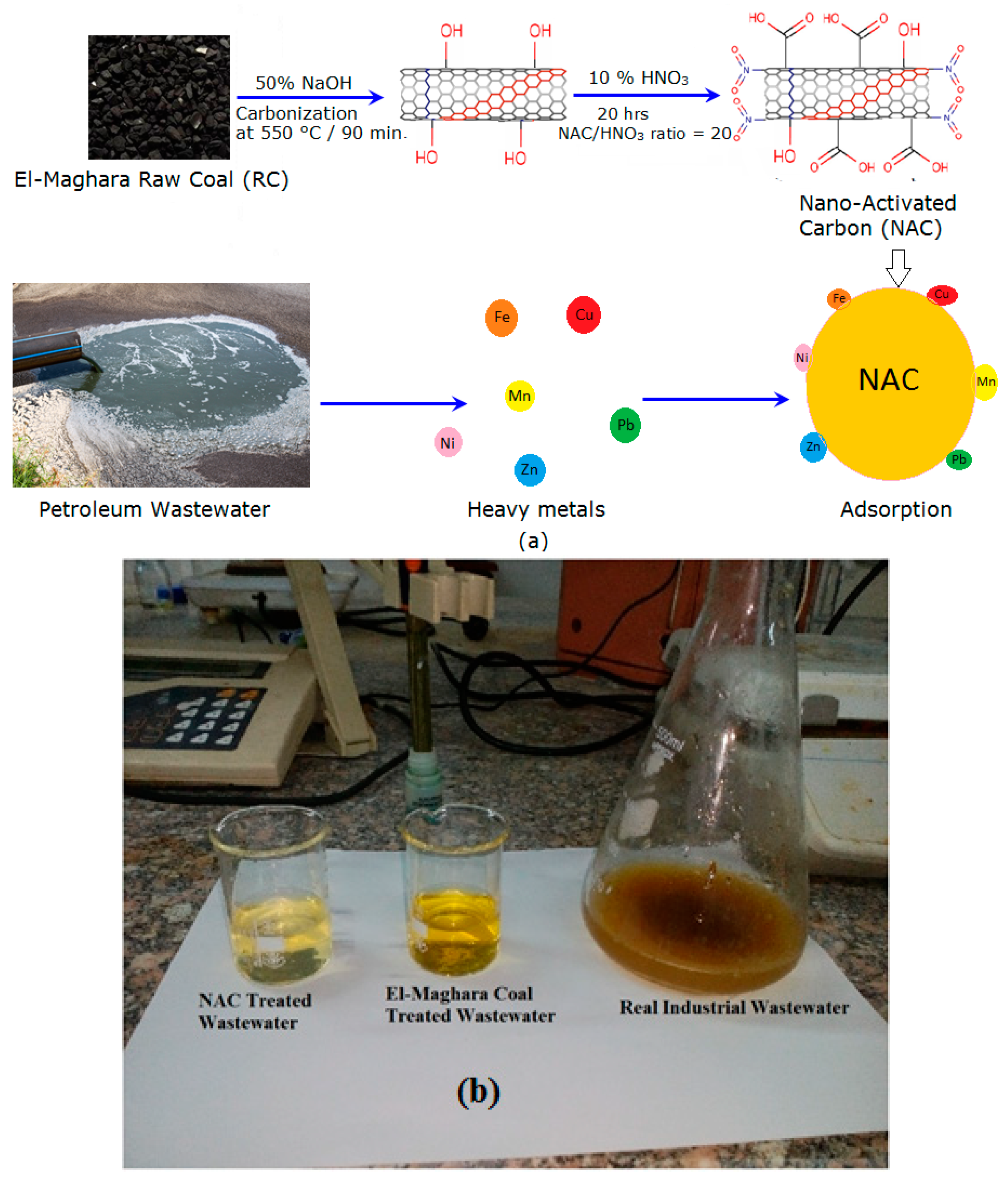

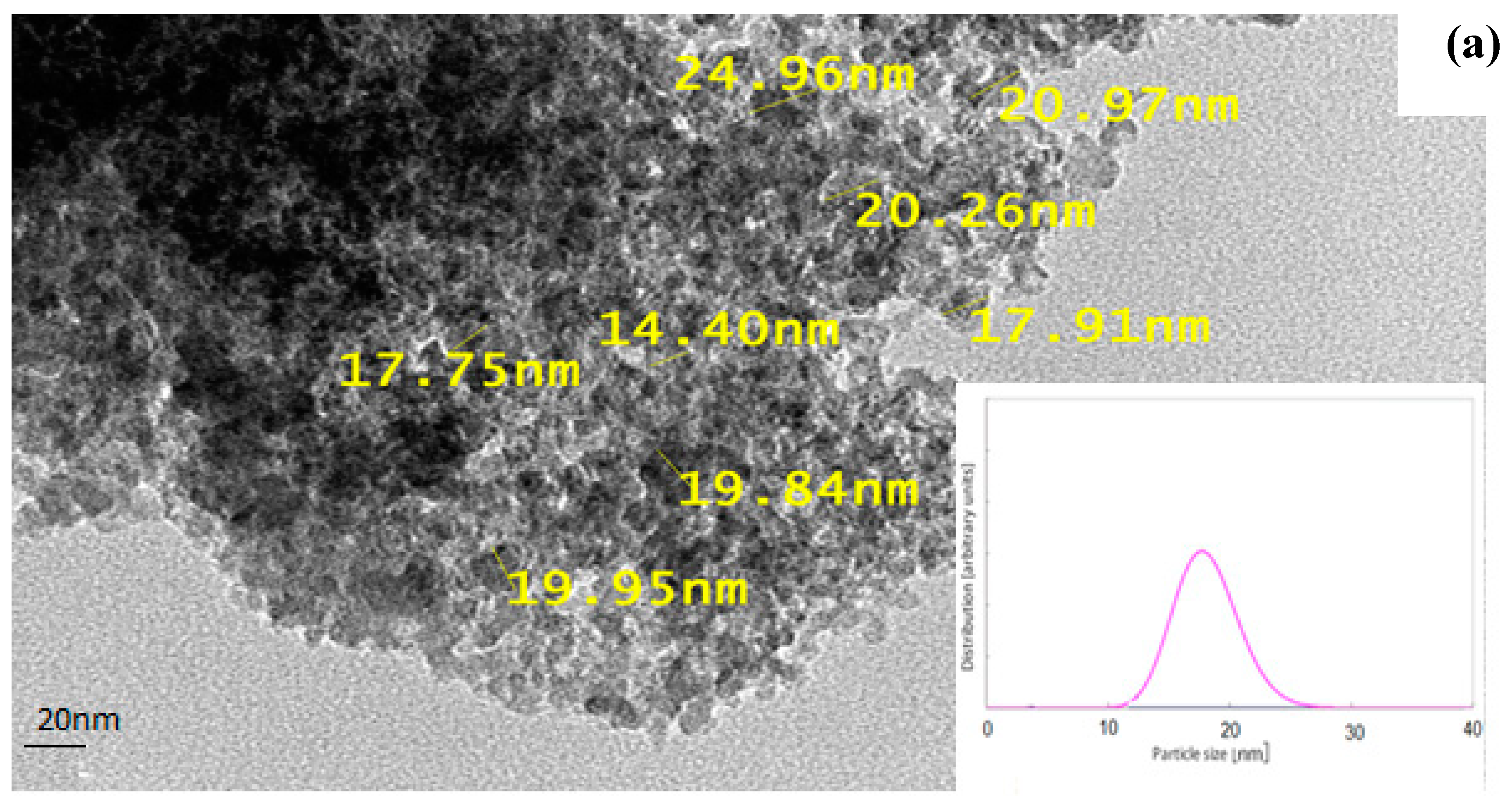
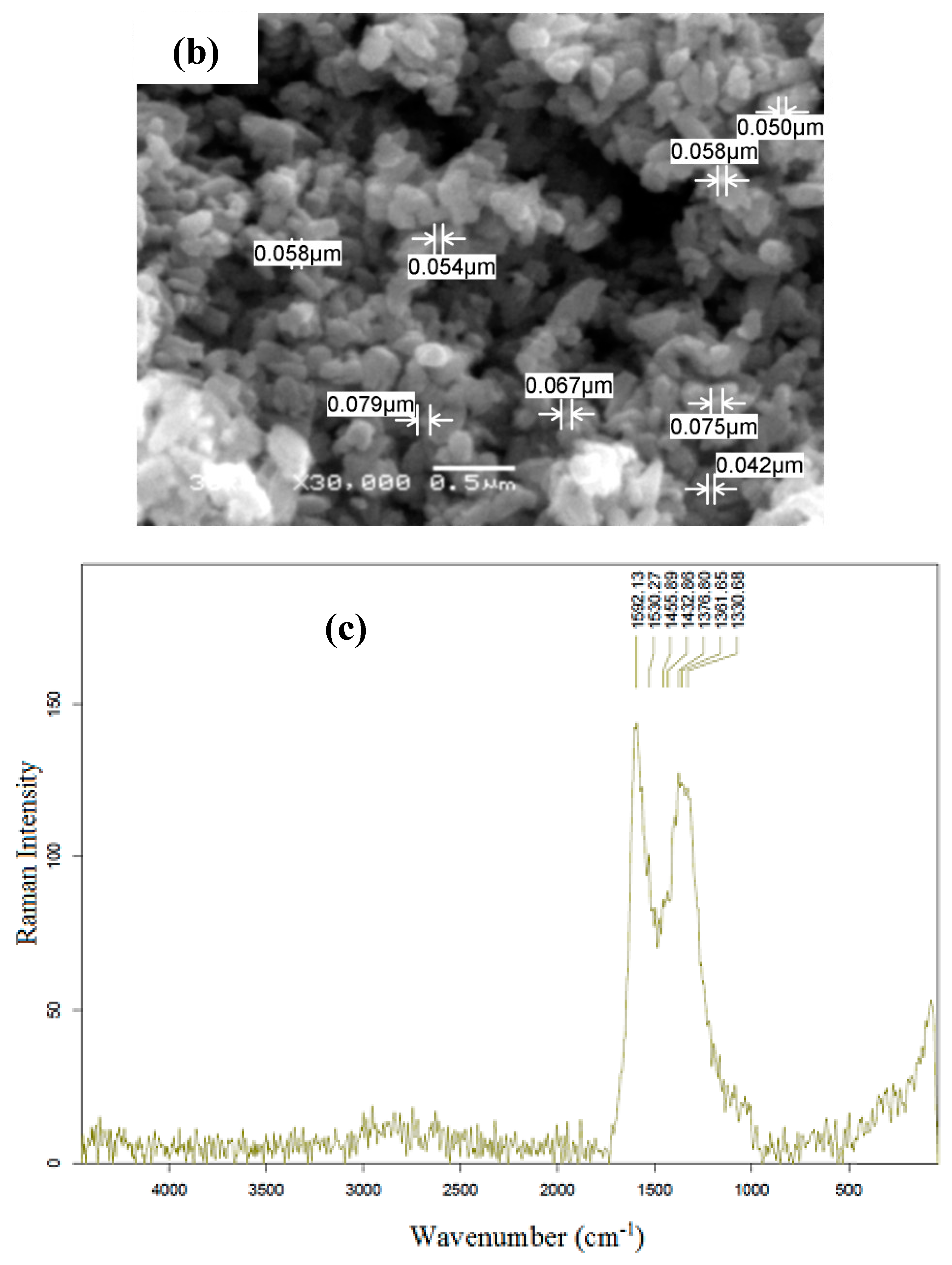

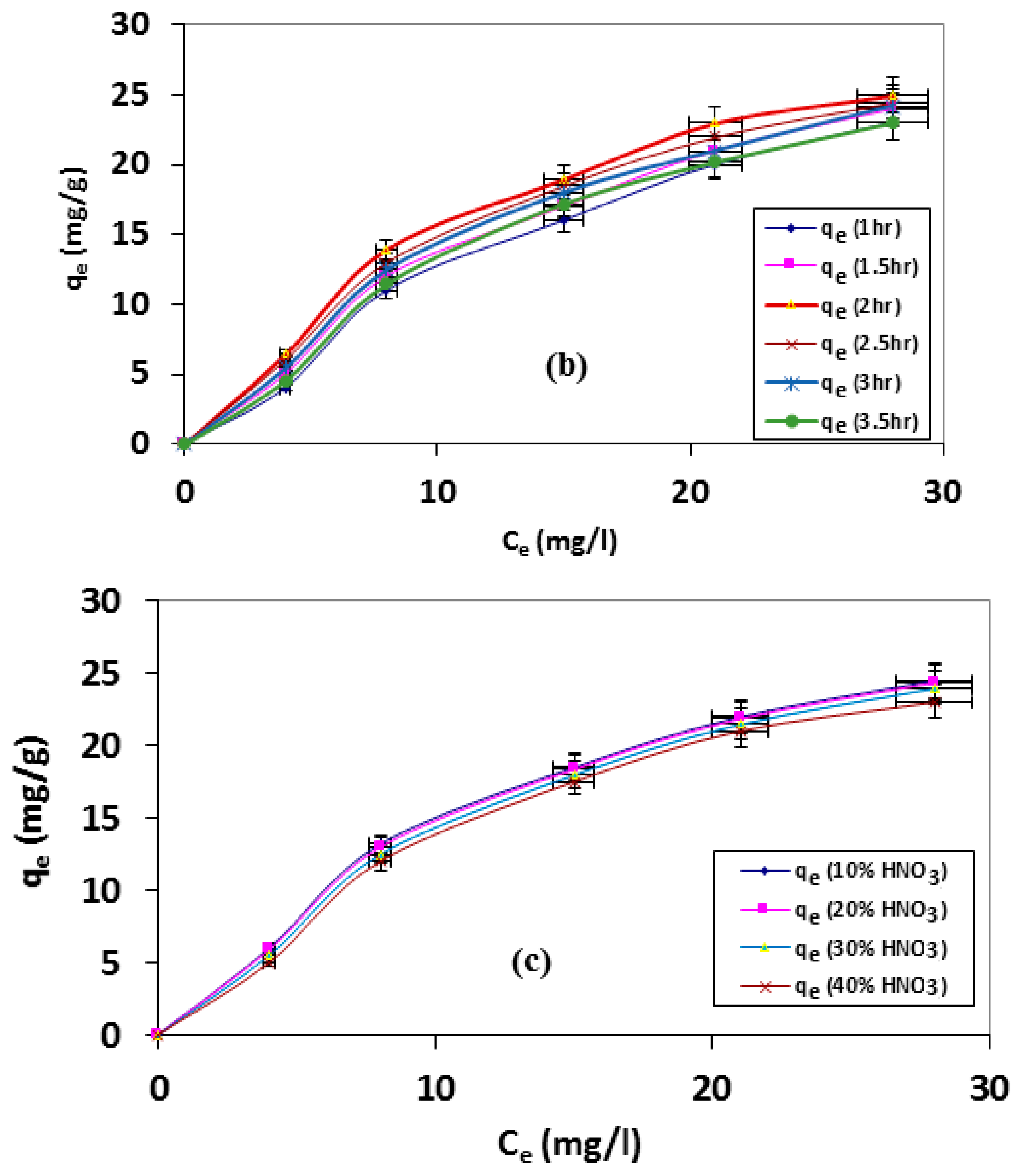
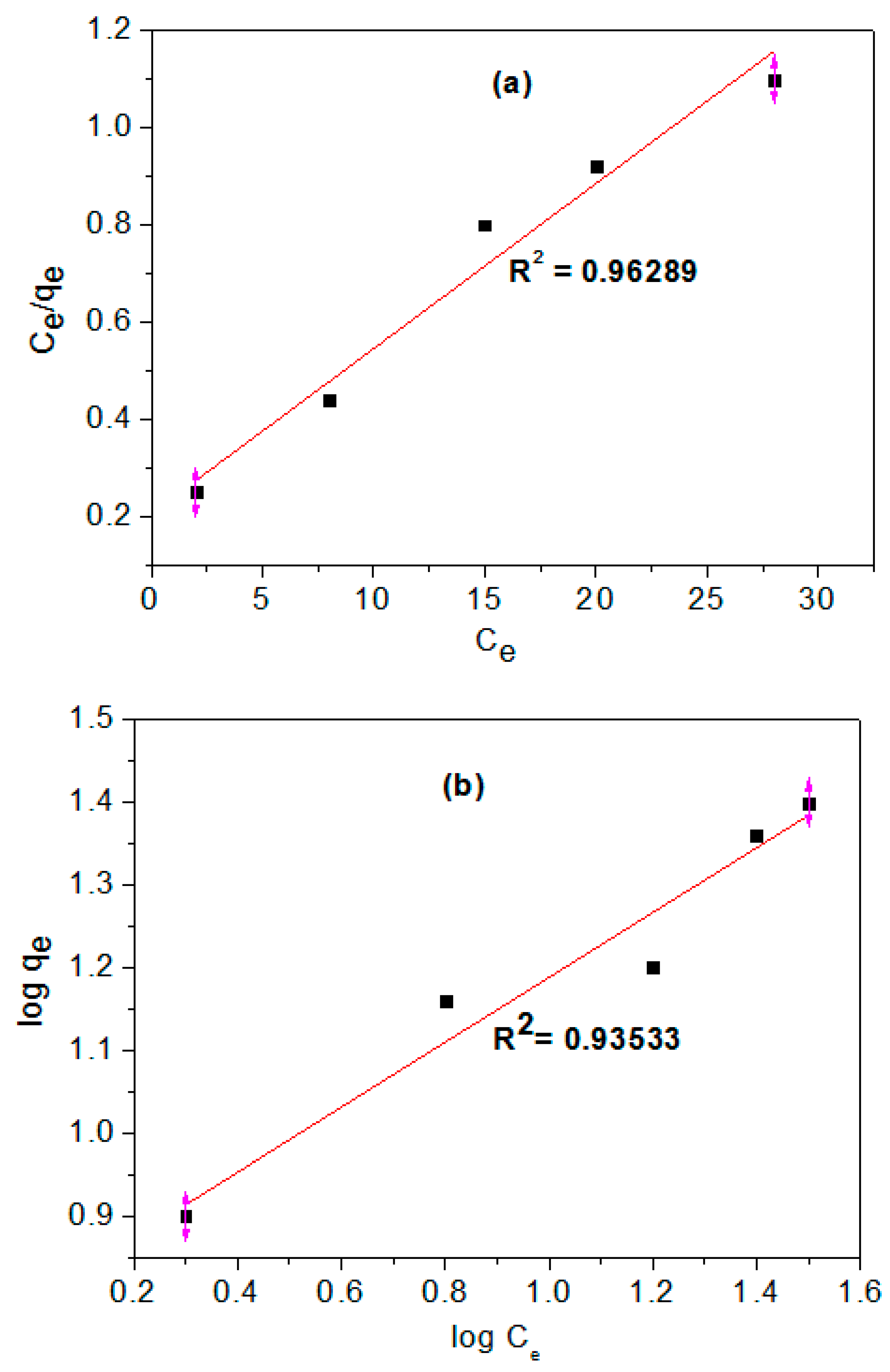
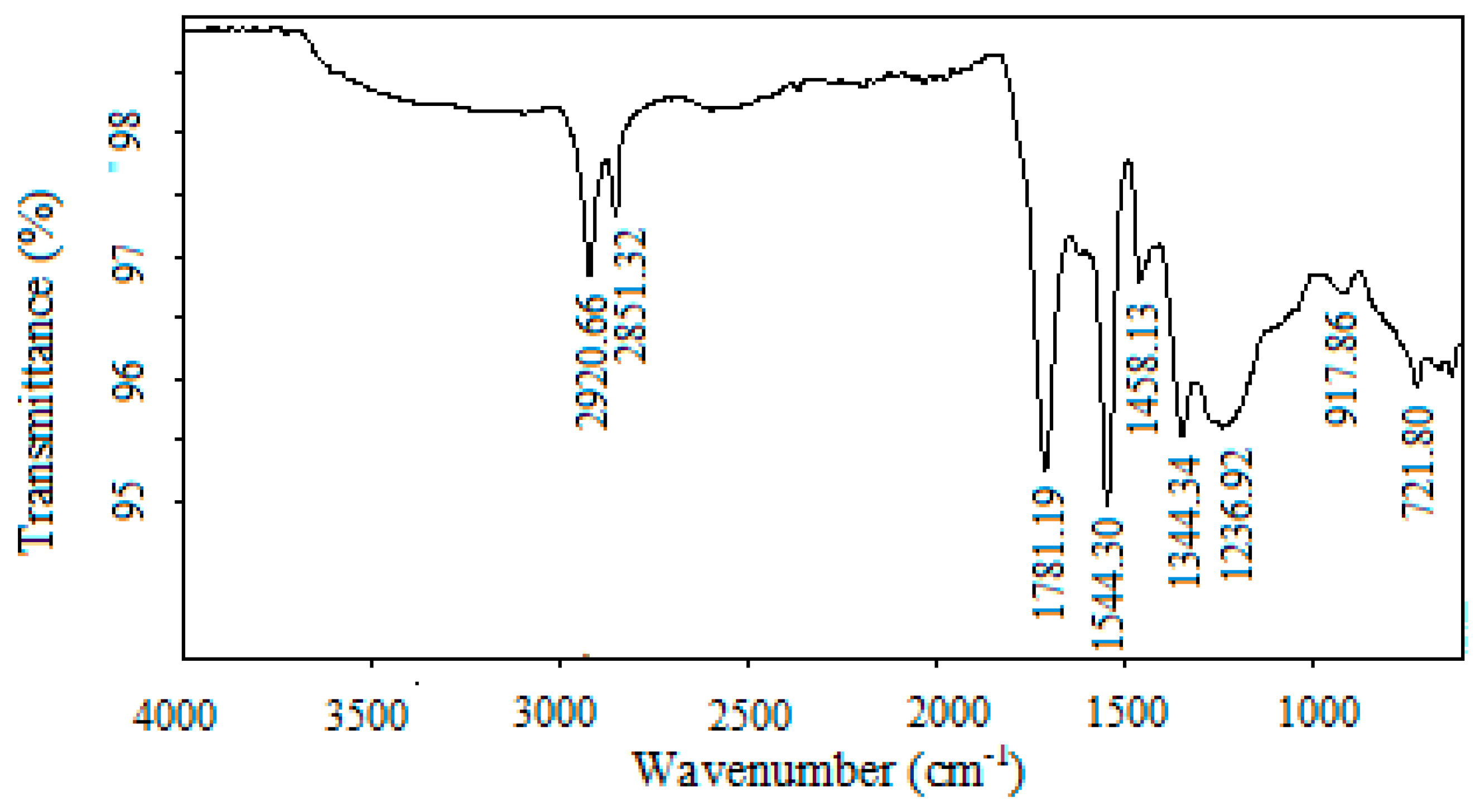

| Coal Type (Rank) | % Carbon | H.V (BTU/Ib) |
|---|---|---|
| Anthracite | 86–98 | 15,000 |
| Bituminous | 45–86 | 10,500–15,500 |
| Sub bituminous | 35–45 | 8300–13,000 |
| Lignite | 25–35 | 4000–8300 |
| Maghara Coal Content | Value (%) |
|---|---|
| Carbon | 71.44 |
| Hydrogen | 6.62 |
| Oxygen | 9.1 |
| Nitrogen | 2.27 |
| Sulphur | 3.8 |
| Adsorption Time (Contact Time) | Final Dye Concentration (ppm) |
|---|---|
| 0 | 30 |
| 10 | 21.1 |
| 20 | 14.2 |
| 30 | 8.6 |
| 40 | 3.1 |
| 50 | 2.8 |
| 60 | 2.6 |
| 75 | 2.5 |
| 90 | 2.5 |
| 105 | 2.4 |
| Elements | Weight (%) | Atomic (%) |
|---|---|---|
| C | 80.5 | 85.4 |
| O | 12.6 | 10.1 |
| N | 6.4 | 4.4 |
| K | 0.34 | 0.08 |
| S | 0.16 | 0.02 |
| Isotherm | Parameters | Value |
|---|---|---|
| Langmuir | qm (mg/g) | 29.50 |
| Ka (L/mg) | 0.165 | |
| R2 | 0.963 | |
| Freundlich | Kf (mg/g(L/g)1/n) | 2.217 |
| n | 2.551 | |
| R2 | 0.935 |
| Metal Ion | Initial Concentration (ppm) | Final Concentration (RC) | Final Concentration (NAC) |
|---|---|---|---|
| Fe(II) | 3.2 | 2.176 | 1.696 |
| Ni(II) | 0.664 | 0.4316 | 0.34528 |
| Cu(II) | 1.18 | 0.7316 | 0.5546 |
| Zn(II) | 2.45 | 1.176 | 1.078 |
| Mn(II) | 1.75 | 1.33 | 1.19 |
| Pb(II) | 1.86 | 0.7254 | 0.8742 |
© 2020 by the authors. Licensee MDPI, Basel, Switzerland. This article is an open access article distributed under the terms and conditions of the Creative Commons Attribution (CC BY) license (http://creativecommons.org/licenses/by/4.0/).
Share and Cite
Elkady, M.; Shokry, H.; Hamad, H. New Activated Carbon from Mine Coal for Adsorption of Dye in Simulated Water or Multiple Heavy Metals in Real Wastewater. Materials 2020, 13, 2498. https://doi.org/10.3390/ma13112498
Elkady M, Shokry H, Hamad H. New Activated Carbon from Mine Coal for Adsorption of Dye in Simulated Water or Multiple Heavy Metals in Real Wastewater. Materials. 2020; 13(11):2498. https://doi.org/10.3390/ma13112498
Chicago/Turabian StyleElkady, Marwa, Hassan Shokry, and Hesham Hamad. 2020. "New Activated Carbon from Mine Coal for Adsorption of Dye in Simulated Water or Multiple Heavy Metals in Real Wastewater" Materials 13, no. 11: 2498. https://doi.org/10.3390/ma13112498






